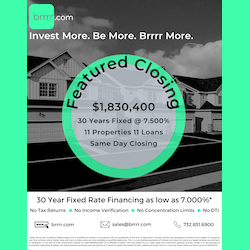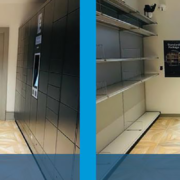Wealth Creation in a Hyperinflationary America
|
Getting your Trinity Audio player ready...
|
By Rick Tobin
Are we currently experiencing the best economic boom ever with all-time record high stock and real estate prices? Or are more investors moving their weakening dollars into hard assets like real estate, partly as a hedge against skyrocketing inflation trends? Can Quantitative Easing ever end, or have the Federal Reserve and US Treasury created a seemingly infinite hyperinflationary spiral?
Home values have never been higher in many U.S. regions than what we’ve all seen here in 2024. The Dow Jones index also recently reached an all-time peak high of 40,000 and the NASDAQ surpassed 17,000 for the first time ever.

American mortgage holders may now have access to a staggering $11 trillion in tappable equity that’s over and above their existing mortgage balances, according to the May 2024 Mortgage Monitor report from the Intercontinental Exchange (ICE).
The amount of residential property equity is so massive that if all 48 million homeowners spent $10 million of their tappable equity each day, it would take more than 3,000 years to exhaust it, as per ICE. This amount of residential equity available is more money than the Gross Domestic Product (GDP) of Japan, India, and the United Kingdom combined.
The West Coast Gold Rush

The same ICE report identified just five housing markets on the West Coast that represented a quarter of that $11 trillion equity number: Los Angeles, San Francisco, San Jose, San Diego, and Seattle. Four of these five core equity cities are located in the Golden State of California.
As per a study released by Zillow, approximately 20% of our nation’s total housing value is in California. With an estimated 40 million residents in California and upwards of 333 Americans across the nation, the state residents represent close to 12% of all Americans. Yet, our state home values represent a much higher 20% number as compared with the rest of America.
Homeowners usually need income first to qualify for a third-party mortgage to purchase their home. While the cost of living for West Coast residents is typically near the highest in the nation, the salaries paid out by many employers, or the income generated by self-employed workers, is also among the highest in the nation with San Francisco, San Jose, and Seattle ranking first, second, and third nationally for the top average salary, according to CareerBuilder.
article continues after advertisement

The Top 5 Most Unaffordable Housing Regions
Three of the Top 5 most unaffordable housing regions in America are located in Southern California – #1 Los Angeles, #3 Irvine, and #5 Long Beach. Miami was #2 and New York City was #4, as per the RealtyHop Housing Affordability Index for May 2024.
Average families who earned the median income in Los Angeles must now spend a shockingly high percentage of 99.33% of their income on home ownership costs, as discovered in this RealtyHop survey. If true, the average Los Angeles resident would have just 0.67% (or less than 1%) of household income left over to purchase groceries and pay for utilities, automobiles, clothing, home maintenance, and other basic necessities if they were actually able to qualify for a home mortgage with those very high debt-to-income ratios.
Rounding out the Top 20 for the most unaffordable housing cities in America, which included many more California regions, were as follows:

6. Newark, NJ
7. Anaheim, CA
8. San Diego, CA
9. San Jose, CA
10. Boston, MA
11. San Francisco, CA
12. Santa Ana, CA
13. Oakland, CA
14. Chula Vista, CA
15. Fremont, CA
16. Jersey City, NJ
17. Austin, TX
18. Dallas, TX
19. Riverside, CA
20. Seattle, WA
These Top 5 most unaffordable housing regions in the survey compared the median home listing price primarily with the median income for the same region. Let’s take a look below at how high the percentage of household income was needed to cover the project monthly household expenses (mortgage, property taxes, insurance, etc.):

The Top 5 Most Affordable Housing Regions
Now, let’s review the Top 5 most affordable cities in America, which have much lower percentage of income to monthly household payment numbers:

Out of the 100 major cities analyzed by RealtyHop, a whopping 88 of the cities had homebuyers paying more than 30% of their monthly income towards household expenses.
The RealtyHop report findings were based on factors such as the percentage of income required to afford a home, a 30-year fixed mortgage rate of 7.125% (subject to change), and projected household income based on US Census and BEA data.
While there are many cities and towns across the nation with much higher median home values than the Top 5 most unaffordable housing regions listed by Realtyhop, those areas usually had much higher household income averages that helped make the home purchases more affordable.
article continues after advertisement

Income Requirements for Homes by State
Families who live in the five most expensive U.S. states for home purchases require an annual income exceeding $270,000 to live comfortably, according to a report published by Visual Capitalist.
“Comfortable” is defined as the income required to cover a 50/30/20 budget, with 50% set aside for necessities like housing and utilities, 30% for discretionary spending, and 20% allocated for savings or investments, as per the same Visual Capitalist report.
The Top 10 most expensive states for two working adults who are raising two children is listed as follows:

Because home values are so much higher today, the average mortgage balance debt is dramatically rising for many borrowers. One-to-four residential mortgage debt has also reached all-time record highs just north of $20 trillion dollars, as per the St. Louis Fed’s Economic Data.
Investments and Wealth Creation

“If you don’t find a way to make money while you sleep, you will work until you die.” – Warren Buffett
If you’re fortunate to own assets, your net worth is probably rapidly increasing. If not, the declining purchasing power of the dollar is making it very challenging for tens of millions of Americans to pay their bills on time.
There’s another old saying that is somewhat similar to Mr. Buffett’s quote that’s as follows: “Either you work hard for your money or your money works hard for you.”
Our towns, cities, states, and our nation are spending money like never before in U.S. history. The federal government continues to increase our debt at a pace of close to $1 trillion dollars every 90 days.
Between January 2020 and October 2021, the M1 money supply (cash or cash-like instruments) grew from $4 trillion to $20 trillion as I’ve written before. The more money that is created and the larger our federal debt grows and compounds, the weaker the purchasing power of the dollar.
For those people who don’t own any real estate or stocks, they are not experiencing firsthand the record wealth being created for many Americans.

Inflation is more likely than not to grow at a faster pace in the near future than what we’ve seen over the past 50 years or so. If so, real estate has proven to be an exceptional hedge against inflation as properties tend to appreciate on a historical average at least as high as the published annual inflation rates.
If you’re lucky enough to own one or more properties today, then you might consider pulling some equity out of the home to acquire more income-producing assets. For first-time homebuyers, today may be the best time to start looking for properties.
A home near you that you consider to be “too expensive” might seem very reasonable five years from now as inflation keeps rising and our dollar gets weaker and weaker.

Rick Tobin
Rick Tobin has worked in the real estate, financial, investment, and writing fields for the past 30+ years. He’s held eight (8) different real estate, securities, and mortgage brokerage licenses to date and is a graduate of the University of Southern California. He provides creative residential and commercial mortgage solutions for clients across the nation. He’s also written college textbooks and real estate licensing courses in most states for the two largest real estate publishers in the nation; the oldest real estate school in California; and the first online real estate school in California. Please visit his website at Realloans.com for financing options and his new investment group at So-Cal Real Estate Investors for more details.
Learn live and in real-time with Realty411. Be sure to register for our next virtual and in-person events. For all the details, please visit Realty411.com or our Eventbrite landing page, CLICK HERE.












